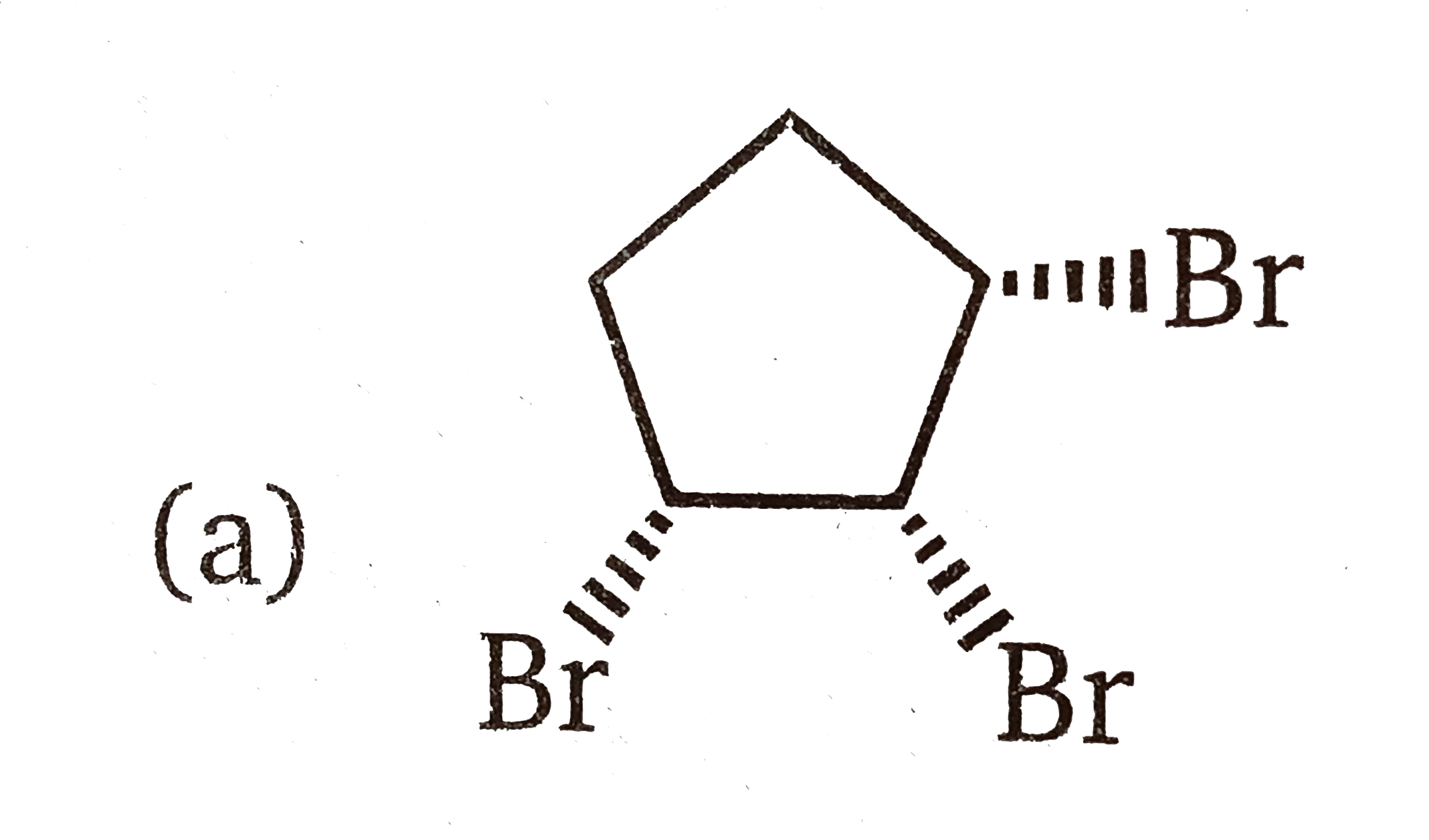Maleic acid reacts with Br2/CCl4 The production
Meso-2, 3-dibromosuccinic acid
(−+) 2, 3-dibromosuccinic acid
(+) 2, 3-dibromosuccinic acid
(−) 2, 3-dibromosuccinic acid
The correct Answer is:B
To solve the problem of the reaction between maleic acid and bromine in the presence of carbon tetrachloride (CCl4), we can follow these steps:
Step 1: Understand the Structure of Maleic Acid
Maleic acid is a dicarboxylic acid with the following structure:
- It has two carboxylic acid groups (-COOH) and a double bond between two carbon atoms.
- The structure can be represented as:
HOOC−CH=CH−COOH
Step 2: Identify the Reaction Conditions
The reaction takes place in the presence of bromine (Br2) and carbon tetrachloride (CCl4). CCl4 is used as a solvent that does not participate in the reaction.
Step 3: Mechanism of the Reaction
1. The double bond in maleic acid will react with bromine. The π electrons of the double bond will attack a bromine molecule (Br2), leading to the formation of a bromonium ion.
2. The bromonium ion is a cyclic structure where one bromine atom is positively charged and attached to one of the carbon atoms of the double bond.
Step 4: Formation of Products
1. The bromonium ion can be attacked by a bromide ion (Br-) at either of the two carbon atoms involved in the double bond.
2. This leads to the formation of two different products due to the possibility of bromine attacking from either side of the bromonium ion.
Step 5: Draw the Products
The two products formed can be represented as:
- Product 1:
HOOC−CHBr−CHBr−COOH
- Product 2:
HOOC−CHBr−CHBr−COOH
Step 6: Analyze the Stereochemistry
1. Both products are stereoisomers and will have different configurations at the carbon atoms where bromine is attached.
2. Since the two products are formed in equal amounts, they will create a racemic mixture (equal amounts of both enantiomers).
Step 7: Naming the Products
The products can be named as:
- 2,3-dibromosuccinic acid, since the original maleic acid is transformed into succinic acid with two bromine substituents.
Final Answer
The reaction of maleic acid with Br2 in CCl4 produces a racemic mixture of 2,3-dibromosuccinic acid.
---
Maleic acid is a dicarboxylic acid with the following structure:
- It has two carboxylic acid groups (-COOH) and a double bond between two carbon atoms.
- The structure can be represented as:
HOOC−CH=CH−COOH
The reaction takes place in the presence of bromine (Br2) and carbon tetrachloride (CCl4). CCl4 is used as a solvent that does not participate in the reaction.
1. The double bond in maleic acid will react with bromine. The π electrons of the double bond will attack a bromine molecule (Br2), leading to the formation of a bromonium ion.
2. The bromonium ion is a cyclic structure where one bromine atom is positively charged and attached to one of the carbon atoms of the double bond.
1. The bromonium ion can be attacked by a bromide ion (Br-) at either of the two carbon atoms involved in the double bond.
2. This leads to the formation of two different products due to the possibility of bromine attacking from either side of the bromonium ion.
The two products formed can be represented as:
- Product 1:
HOOC−CHBr−CHBr−COOH
HOOC−CHBr−CHBr−COOH
1. Both products are stereoisomers and will have different configurations at the carbon atoms where bromine is attached.
2. Since the two products are formed in equal amounts, they will create a racemic mixture (equal amounts of both enantiomers).
The products can be named as:
- 2,3-dibromosuccinic acid, since the original maleic acid is transformed into succinic acid with two bromine substituents.
The reaction of maleic acid with Br2 in CCl4 produces a racemic mixture of 2,3-dibromosuccinic acid.
Topper's Solved these Questions
- HYDROCARBONSBOOK - PHYSICS WALLAHCHAPTER - HYDROCARBONSEXERCISE - NEET PAST 5 YEARS QUESTIONS
27 Videos
- HALOALKANES AND HALOARENES BOOK - PHYSICS WALLAHCHAPTER - HALOALKANES AND HALOARENES EXERCISE - NEET PAST 5 YEARS QUESTIONS
7 Videos
- HYDROGENBOOK - PHYSICS WALLAHCHAPTER - HYDROGENEXERCISE - LEVEL-2
58 Videos
Similar Questions
Knowledge Check
(R)-3-bromocyclopentene (shown below) reacts with Br2/CCl4 to form two products, Y and Z, Y is not optically active (does not rotate plane-polarized light). What is the structure of Y
 A
A B
B C
C D
D
A C6H12O compound does not react with Br2 in CCl4, produces a flammable gas on treatment with LiAlH4, and reacts with H2CrO4 changing the color from orange to green. Which of the following compounds best agrees with these facts?
A1-methylcyclopentanolBmethoxycyclopentaneC2-cyclopropyl-2-propanolD2-cyclobutylethanolDuring an experimental workup procedure, a chemist treated a starting material with NaoH in the solvent acetone [(CH3)2C=O], however, the starting material was recovered unreacted. Instead, the chemist isolated a small amount of product A (shown below).
Product A
1. Elemental analysis of product A indicated that it consisted only of carbon, hydrogen, and oxygen.
2. Product A had a molecular weight of 116 g/mol.
3. Product A was a methyl ketone because it gave a positive iodoform test.
4. When product A was treated with Br2 in CCl4, the red bromine colour persisted, because no carbon-carbon double bonds were present to react with the bromine.
The structure of product A was further confirmed when treatment with hot sulfuric acid resulted in the corresponding dehydration product, product (B).
Q. When a drop of Br2 in CCl4 is added to product B, the resulting solution will ewAcolourless, because product B does not contains a carbon-carbon double bond.Bcolourless, because product B contians a carbon-carbon double bondCred, because product B does not contain-carbon double bond.Dred, because product B contains a carbon-carbon double bond.
When
 is mixed and reacted with Br2KOH then how many products are obtained.
is mixed and reacted with Br2KOH then how many products are obtained.
View SolutionAn organic compound on treatment with Br2/CCl4, gives a bromoderivative alkene. The compound will be
View SolutionCyclohexene reacts with Br2inCCl4 to form
View SolutionMaleic acid is found in the -
View SolutionPhenol reacts with Br2 in CCl4 at low temperature to give
View Solution
